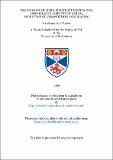Files in this item
The ecology of hard-substratum epifaunal assemblages : effects of larval recruitment, competition and grazing
Item metadata
| dc.contributor.advisor | Todd, Christopher David | |
| dc.contributor.author | Turner, Stephanie Jane | |
| dc.coverage.spatial | 300 p. | en_US |
| dc.date.accessioned | 2018-06-12T12:50:54Z | |
| dc.date.available | 2018-06-12T12:50:54Z | |
| dc.date.issued | 1989 | |
| dc.identifier.uri | https://hdl.handle.net/10023/13951 | |
| dc.description.abstract | Artificial substrata were employed at sites on the east and west coasts of Scotland, in such a manner as to model the habitat found on the undersides of boulders on the shore. Panel treatments were devised to examine the effects of substratum 'age' and larval availability, and the presence or absence of varying densities of herbivorous molluscan grazers on the development of the epifaunal assemblages. The importance of inter- and intraspecific competition in structuring the bryozoan component of the assemblage was also examined. A necessary pre-requisite for the settlement of many marine invertebrate larvae may be the development of a microfouling film, the nature of which may vary depending on its 'age', with corresponding effects on the 'attractiveness', or otherwise, to potentially settling larvae. The lowest numbers of recruits were frequently recorded on the 'youngest' panels, and greater numbers generally occurred on panels immersed for longer periods. Also of overriding significance, however, was the seasonal variability in larval availability. The assemblages were characterized by high levels of post-settlement mortality. The outcomes of the overgrowth interactions between 18 species of encrusting bryozoans were highly variable and complex, each species of an interacting pair won some encounters, and neither consistently overgrew the other. Therefore, the pattern of competitive abilities was neither entirely intransitive or transitive. Variations in outcome were found to be at least partially attributable to differences in the encounter angle between colonies. The competitive ability of a species also varied among sites and between years. The herbivorous grazing gastropod Gibbula cineraria was found to have a markedly deleterious effect on the developing assemblages. Furthermore, individuals and colonies of the epifaunal species were apparently unable to achieve an 'escape-in-size' under the experimental conditions employed. | en_US |
| dc.language.iso | en | en_US |
| dc.publisher | University of St Andrews | |
| dc.subject.lcc | QH541.5S35T9 | en |
| dc.subject.lcsh | Coastal ecology | en |
| dc.title | The ecology of hard-substratum epifaunal assemblages : effects of larval recruitment, competition and grazing | en_US |
| dc.type | Thesis | en_US |
| dc.type.qualificationlevel | Doctoral | en_US |
| dc.type.qualificationname | PhD Doctor of Philosophy | en_US |
| dc.publisher.institution | The University of St Andrews | en_US |
This item appears in the following Collection(s)
Items in the St Andrews Research Repository are protected by copyright, with all rights reserved, unless otherwise indicated.

